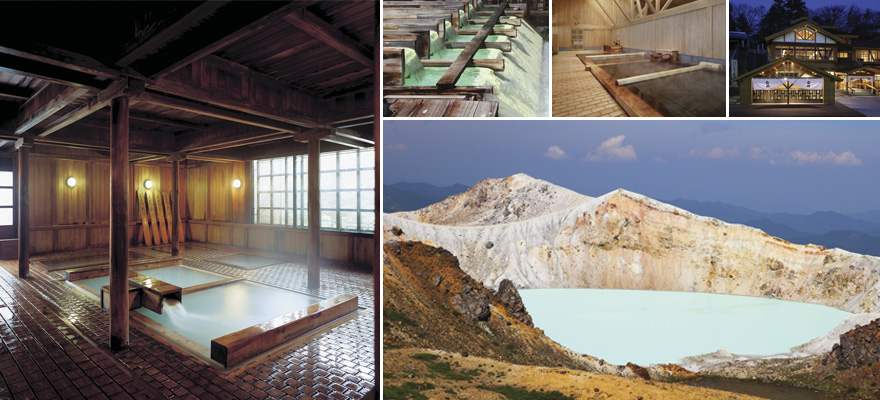Home > Highlighting JAPAN > Highlighting Japan August 2013 > Gunma
Highlighting JAPAN
47 Prefectures from A to Y
Gunma
Kusatsu Onsen

Kusatsu, located about three hours from Tokyo in Gunma Prefecture, is well known for its hot springs. With over 100 onsen baths, Kusatsu has become a Mecca for visitors wishing to bathe in natural thermal waters that are also thought to have healing powers.
The bus terminal—the central hub for receiving visitors—houses the Kusatsu Hot Spring Museum on the third floor, and details the history of Kusatsu, its many traditions, local persons of note and the development of the hot spring industry.
The hot springs result from a natural geological phenomenon. Groundwater heated by volcanic gas becomes imbued with various minerals on its way up to the surface. The resulting geothermal spring attains a distinctive color and is very acidic at first, but this is neutralized by the upper limestone strata in a natural process. Acid-resistant pumps are then used to transport the water to the surface and the citizens of Kusatsu also use the hot water from Bandai Mine Springs for heating and thermal energy.
At the center of town is the yubatake, or the "hot water field." As one of the biggest hot springs in Japan, the emerald water is routed outdoors through several wooden canals and down a small waterfall. The names of 100 famous people decorate the stone railings that surround the yubatake.
Adjacent to the yubatake is Netsu-no-Yu, a ceremonial hall where visitors can watch the traditional practice of yumomi (literally, "hot water rubbing"). It has developed into a daily ritual also involving dancing and music. Waters coming into the hot-spring town are too hot for bathing (temperatures ranging from 50°C to 90°C) and so the yumomi process of stirring is used to cool temperatures before the hot spring waters flow on to the various bath houses. A group of women use ita (wooded paddles) to cool the hot-spring water rather than mixing it with colder water. Why? Because spring water would dilute the spring's healing powers.
In the Meiji period (1868-1912), a taicho (now called a yucho) or group leader, would supervise the mixers in this cooling process. Once their work was completed, the stirrers themselves would also briefly bathe in the spring, using a hishaku (ladle) to pour water over their heads. Visitors today have the chance to participate and receive a certificate in performing yumomi.
There are many ways to enjoy the hot springs in Kusatsu: foot-bathing, one-day visitor bathhouses, outdoor baths (rotenburo) or one of many privately-owned spas in the surrounding hotels.
Many shrines and Buddhist statues can be found in Kusatsu, often received as gifts from pilgrims from ages past. Most noticeable are Jizo, a Bodhisattva of healing and protector of travelers, women and children. Another famous sight is the yutaki toro (Yutaki stone lantern) located above the small but picturesque waterfall that gushes over the edge of the yubatake. The lantern was erected in 1830 and sometimes relives its former role when townspeople would light an oil lamp inside so as to illuminate the town center.
Other statues placed around town celebrate a number of writers and intellectuals, including two busts of foreign doctors: Drs. Julius Scriba and Erwin Bälz from Germany. In the Meiji Era, Germany had the most advanced study of medicine and these two doctors were invited to teach at the Medical School of Tokyo Imperial University. Dr. Scriba also acted as foreign advisor to the Japanese Government and contributed greatly to the development of Western medicine in Japan, whereas Dr. Bälz was both a foreigner advisor and a court physician to the Emperor. He also researched the medicinal benefits of the hot springs in Kusatsu, where a museum is built in his honor.
The side streets of Kawahara-dori and Yutaki-dori have much to offer visitors, including restaurants, craft shops and snack vendors. Two shops of note are Saiyo Honey that specializes in Kumamoto honeys and natural products, and Kusatsu Choju-ten ("shop of long life" that makes manju and green tea, offering free samples to visitors. The manju are freshly steamed on site and come in many flavors: green tea, sweet red bean or hazelnut.
The area surrounding Kusatsu Onsen also has much to offer, being in a mountainous region of Gunma. Most notable of all is Mount Shirane, an active volcano located on a 30-minute bus ride (¥2000) from Kusatsu Bus Terminal. Many hiking paths lead to the 2160-meter pinnacle and its observatory. It offers spectacular views of the surrounding landscape, including Yugama, an ice blue crater-lake that can be visited on foot, unless there is volcanic activity.
At least an overnight stay is required to truly take in all of the sites and experiences of Kusatsu Onsen. It truly forms one of the many natural wonders of Gunma Prefecture.
© 2009 Cabinet Office, Government of Japan






